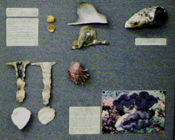
CLASS BIVALVIA
Introduction
The 2000 species of bivalves (clams, mussels, oysters) have shells with two dorsally hinged valves that completely enclose a laterally compressed body. Bivalves are adapted for burrowing in mud and sand. The foot is usually compressed, blade-like and directed anteriorly. The head is very poorly developed without a buccal mass or radula. The gills are very large and in most species collect food as well as being used for gas exchange. Although modern bivalves live in a variety of habitats they are all chained to a sedentary existence. Bivalves range in size from the tiny seed shells of the freshwater family Sphaeridae to the giant clam Tridacna sp. which can be over a metre long and weigh up to 1200 kg. There are two main kinds of bivalves: Protobranchs and Lamellibranchs.
|
|||||||||||||||||||||||||||||||||||||||||||||||||||||||||||||||||||||||||||||||||||||||||||||||||||||||||
Select an area or choose a link for more information.





















